Test Research on Residual Mechanical Properties of Fiber-Reinforced Concrete Segments after High Temperature
Abstract
:1. Introduction
2. Test Methods
2.1. Test Sample Introduction
2.2. Test Device
2.3. Measurement Methods
2.3.1. Displacement Measurement Method
2.3.2. Strain Measurement Method
2.3.3. Crack Width Measurement Method
2.4. Loading Method
3. Test Phenomena
3.1. Segments after Exposure to High Temperature
3.1.1. RC-1-PF
3.1.2. RC-2-PF
3.1.3. HFRC-3-PF
3.1.4. HFRC-4-PF
3.1.5. HFRC-5-PF
3.2. Room-Temperature Segments
3.2.1. RC-6
3.2.2. HFRC-7
3.3. Contrast Analysis
- (1)
- The damage mode of the segments after exposure to high temperature and the segments at room temperature were crushed in the pressurized zone, and the high temperature had little effect on the concrete in the pressurized area, so the bearing capacity after high temperature was reduced by 10% to 20%. For fiber-free segments, incorporating fiber increased the carrying capacity of the room-temperature segments by 28%, indicating that in the case of a low reinforcement ratio (0.44%), mixed fibers improved the mechanical properties of the segments significantly. Meanwhile, compared with the RC-1 and HFRC-3 test samples, mixed fiber increased the ultimate bearing capacity of the segments by 19.3%. This shows that in mixed fiber segments after exposure to high temperature, due to the melting of polypropylene fibers, the addition of fibers reduced the increase in the remaining bearing capacity of the segments.
- (2)
- Contrasting the segments HFRC-3 to HFRC-5, it can be seen that the size of the preload at high temperature had little effect on the remaining loading capacity, with losses of 16%, 11%, and 22%, respectively. The impact on the number of cracks was mainly concentrated on the inner arc surface. It should be noted that, compared with the RC-1 and HFRC-3 test samples, the bearing area of the segments bearing-loaded with a positive bending moment was mainly concentrated at the arch foot (joint); the bridging effect of the steel fiber reduced the crushing of the concrete at the arch foot, which shows that the addition of steel fiber can increase the local strength of the weak part of the lining sheet. Meanwhile, the bearing capacity of the segments in the literature [26,27,28] is limited. The bearing capacity of the segments is limited due to pure bending, and the axial force on the opening load and the extreme load of the segments are greatly increased.
- (3)
- After exposure to high temperature, the number of cracks on the side and inner arc surface of the segments increased, and the crack development was concentrated in a few major cracks formed at high temperature. Meanwhile, compared with fiber-free duct segments, mixed fiber made the cracks in the segments obvious; the cracks at the loading point were denser; and the gap between cracks was reduced.
4. Test Results
4.1. Load–Middle Span Displacement Curve
4.2. Load–Strain Curve
4.2.1. Load–Strain Curves of Concrete on the Sides of the Segments
4.2.2. Load–External and Internal Arc Surface Strain Curves
4.2.3. Load–Reinforcement Strain Curve
4.3. Load–Crack Width Curve
5. Conclusions
- (1)
- The load–middle span displacement change rules for each segment are the same, and the increase in displacement slows down between 500 kN and 600 kN. Whether the segment had been exposed to room temperature or high temperature, the ultimate deformation of unmixed fiber segments was lower than the limited deformation of those with incorporated mixed fibers; thus, the addition of mixed fibers can increase the extreme deformation of the segment.
- (2)
- As for the concrete strain on the side of the segment, before the concrete cracked, the change in the tensile strain of the concrete was relatively small. After the concrete cracked, following exposure to high temperature, the strain surge increased, while the room-temperature segment strain first developed in the middle span region. Meanwhile, the addition of mixed fibers delayed the development of the concrete strain before cracking.
- (3)
- For the strain of concrete on the outer and inner curved surfaces of the segment, the pressure strain on the outer curved surface of the segment changed linearly with an increase in load, consistent with the development trend of the load–deformation curve. Meanwhile, compared with the fiberless segments, the maximum pressure strain value of the tube edge incorporating fibers was greater.
- (4)
- For the strain of steel bars, the yield strength of steel bars without fiber segments was lower than those with fiber segments, indicating that fiber incorporation bears part of the tensile stress and reduces the strain of longitudinal bars.
- (5)
- For concrete segments after exposure to high temperature, when loading did not exceed 400 kN, the crack width at the loading point and middle span position under different load levels was the same; however, after loading more than 400 kN, the crack width at the loading point increased obviously. For mixed fiber concrete segments, when the load was large, the influence of the fiber on the crack width decreased, and the crack width changed obviously.
Author Contributions
Funding
Institutional Review Board Statement
Informed Consent Statement
Data Availability Statement
Conflicts of Interest
References
- Savov, K.; Lackner, R.; Mang, H. Stability assessment of shallow tunnels subjected to fire load. Fire Saf. J. 2005, 40, 745–763. [Google Scholar] [CrossRef]
- Amouzandeh, A.; Moser, H.; Ring, T.; Zeiml, M.; Lackner, R.; Mang, H.A. Holistic Analysis of Underground Infrastructure Subjected to Fire. Procedia Eng. 2011, 14, 41–51. [Google Scholar] [CrossRef]
- Ingason, H.; Li, Y.Z.; Lönnermark, A. Runehamar tunnel fire tests. Fire Saf. J. 2015, 71, 134–149. [Google Scholar] [CrossRef]
- de Silva, D.; Andreini, M.; Bilotta, A.; De Rosa, G.; La Mendola, S.; Nigro, E.; Rios, O. Structural safety assessment of concrete tunnel lining subjected to fire. Fire Saf. J. 2022, 134, 103697. [Google Scholar] [CrossRef]
- Lee, W.M.; Fragomeni, S.; Monckton, H.; Guerrieri, M. A review of test Methods, issues and challenges of Large-Scale fire testing of concrete tunnel linings. Constr. Build. Mater. 2023, 392, 131901. [Google Scholar] [CrossRef]
- Zhang, G.; Zhang, W.; Zhang, X.; Shangguan, D.; Ling, T.; Guan, L. Evaluation on fire resistance of composite segmental lining for shield tunnel. Tunn. Undergr. Space Technol. 2023, 131, 104781. [Google Scholar] [CrossRef]
- Hua, N.; Khorasani, N.E.; Tessari, A.; Ranade, R. Experimental study of fire damage to reinforced concrete tunnel slabs. Fire Saf. J. 2022, 127, 103504. [Google Scholar] [CrossRef]
- Novak, J.; Kohoukova, A. Fire response of hybrid fiber reinforced concrete to high temperature. Procedia Eng. 2017, 172, 784–790. [Google Scholar] [CrossRef]
- Nehdi, M.L.; Abbas, S.; Soliman, A.M. Exploratory study of ultra-high performance fiber reinforced concrete tunnel lining segments with varying steel fiber lengths and dosages. Eng. Struct. 2015, 101, 733–742. [Google Scholar] [CrossRef]
- Ding, Y.; Zhang, C.; Cao, M.; Zhang, Y.; Azevedo, C. Influence of different fibers on the change of pore pressure of self-consolidating concrete exposed to fire. Constr. Build. Mater. 2016, 113, 456–469. [Google Scholar] [CrossRef]
- Di Carlo, F.; Meda, A.; Rinaldi, Z. Evaluation of the bearing capacity of fiber reinforced concrete sections under fire exposure. Mater. Struct. 2018, 51, 154. [Google Scholar] [CrossRef]
- Nogales, A.; de la Fuente, A. Crack width design approach for fibre reinforced concrete tunnel segments for TBM thrust loads. Tunn. Undergr. Space Technol. 2020, 98, 103342. [Google Scholar] [CrossRef]
- Ning, X.; Li, J.; Li, Y. An Explorative Study into the Influence of Different Fibers on the Spalling Resistance and Mechanical Properties of Self-Compacting Concrete after Exposure to Elevated Temperatures. Appl. Sci. 2022, 12, 12779. [Google Scholar] [CrossRef]
- Ma, R.-Y.; Yang, J.; Peng, G.-F. Influence of steel fiber types on residual mechanical properties and explosive spalling of hybrid fiber reinforced ultra-high performance concrete: Optimization and evaluations. Case Stud. Constr. Mater. 2023, 19, e02538. [Google Scholar] [CrossRef]
- Khan, M.; Lao, J.; Ahmad, M.R.; Dai, J.-G. Influence of high temperatures on the mechanical and microstructural properties of hybrid steel-basalt fibers based ultra-high-performance concrete (UHPC). Constr. Build. Mater. 2024, 411, 134387. [Google Scholar] [CrossRef]
- Serafini, R.; Dantas, S.R.; Agra, R.R.; de la Fuente, A.; Berto, A.F.; de Figueiredo, A.D. Design-oriented assessment of the residual post-fire bearing capacity of precast fiber reinforced concrete tunnel linings. Fire Saf. J. 2022, 127, 103503. [Google Scholar] [CrossRef]
- Lyu, X.; Elchalakani, M.; Ahmed, T.; Sadakkathulla, M.A.; Youssf, O. Residual strength of steel fibre reinforced rubberised UHPC under elevated temperatures. J. Build. Eng. 2023, 76, 107173. [Google Scholar] [CrossRef]
- Habel, K.; Viviani, M.; Denarié, E.; Brühwiler, E. Development of the mechanical properties of an Ultra-High Performance Fiber Reinforced Concrete (UHPFRC). Cem. Concr. Res. 2006, 36, 1362–1370. [Google Scholar] [CrossRef]
- Zhang, Y.; Wang, Y.; Ren, Z. Experimental Study on the Properties of Mixed-Fiber Concrete Shield Tunnel Segments Subjected to High Temperatures. Fire 2023, 6, 17. [Google Scholar] [CrossRef]
- Mezzal, S.K.; Al-Azzawi, Z.; Najim, K.B. Effect of discarded steel fibers on impact resistance, flexural toughness and fracture energy of high-strength self-compacting concrete exposed to elevated temperatures. Fire Saf. J. 2021, 121, 103271. [Google Scholar] [CrossRef]
- Choi, S.-W.; Lee, J.; Chang, S.-H. A holistic numerical approach to simulating the thermal and mechanical behaviour of a tunnel lining subject to fire. Tunn. Undergr. Space Technol. 2013, 35, 122–134. [Google Scholar] [CrossRef]
- Meng, G.; Gao, B.; Zhou, J.; Cao, G.; Zhang, Q. Experimental investigation of the mechanical behavior of the steel fiber reinforced concrete tunnel segment. Constr. Build. Mater. 2016, 126, 98–107. [Google Scholar] [CrossRef]
- GB/T 50152-2012; Ministry of Housing and Urban-Rural Development, People’s Republic of China. Standard for Test Methods of Concrete Structures. China Architecture and Construction Press: Beijing, China, 2012. (In Chinese)
- Gondokusumo, G.S.; Venkateshwaran, A.; Li, S.; Liew, J.R. Residual flexural tensile strength of normal-weight and lightweight steel fibre-reinforced concrete at elevated temperatures. Constr. Build. Mater. 2023, 367, 130221. [Google Scholar] [CrossRef]
- Chrysanidis, T.A.; Panoskaltsis, V.P. Experimental investigation on cracking behavior of reinforced concrete tension ties. Case Stud. Constr. Mater. 2022, 16, e00810. [Google Scholar] [CrossRef]
- Yan, Z.-G.; Shen, Y.; Zhu, H.-H.; Li, X.-J.; Lu, Y. Experimental investigation of reinforced concrete and hybrid fibre reinforced concrete shield tunnel segments subjected to elevated temperature. Fire Saf. J. 2015, 71, 86–99. [Google Scholar] [CrossRef]
- Serafini, R.; Dantas, S.R.; Salvador, R.P.; Agra, R.R.; Rambo, D.A.; Berto, A.F.; de Figueiredo, A.D. Influence of fire on temperature gradient and physical-mechanical properties of macro-synthetic fiber reinforced concrete for tunnel linings. Constr. Build. Mater. 2019, 214, 254–268. [Google Scholar] [CrossRef]
- Sakkas, K.; Vagiokas, N.; Tsiamouras, K.; Mandalozis, D.; Benardos, A.; Nomikos, P. In-situ fire test to assess tunnel lining fire resistance. Tunn. Undergr. Space Technol. 2019, 85, 368–374. [Google Scholar] [CrossRef]
- Liu, X.; Sun, Q.; Song, W.; Bao, Y. Structural behavior of reinforced concrete tunnel linings with synthetic fibers addition. Tunn. Undergr. Space Technol. 2023, 131, 104771. [Google Scholar] [CrossRef]
- Buratti, N.; Ferracuti, B.; Savoia, M. Concrete crack reduction in tunnel linings by steel fibre-reinforced concretes. Constr. Build. Mater. 2013, 44, 249–259. [Google Scholar] [CrossRef]
- Saleheen, Z.; Krishnamoorthy, R.R.; Nadjai, A. A review on behavior, material properties and finite element simulation of concrete tunnel linings under fire. Tunn. Undergr. Space Technol. 2022, 126, 104534. [Google Scholar] [CrossRef]
- Sharghi, M.; Chakeri, H.; Afshin, H.; Török, Á.; Dias, D. Investigation of the feasibility of using recycled steel fibers in tunnel lining segments. Tunn. Undergr. Space Technol. 2021, 110, 103826. [Google Scholar] [CrossRef]
- Caratelli, A.; Meda, A.; Rinaldi, Z.; Romualdi, P. Structural behaviour of precast tunnel segments in fiber reinforced concrete. Tunn. Undergr. Space Technol. 2011, 26, 284–291. [Google Scholar] [CrossRef]
- Del Savio, A.A.; Esquivel, D.L.T.; Landeo, J.M.G. Post-Cracking Properties of Concrete Reinforced with Polypropylene Fibers through the Barcelona Test. Polymer 2023, 15, 3718. [Google Scholar] [CrossRef] [PubMed]
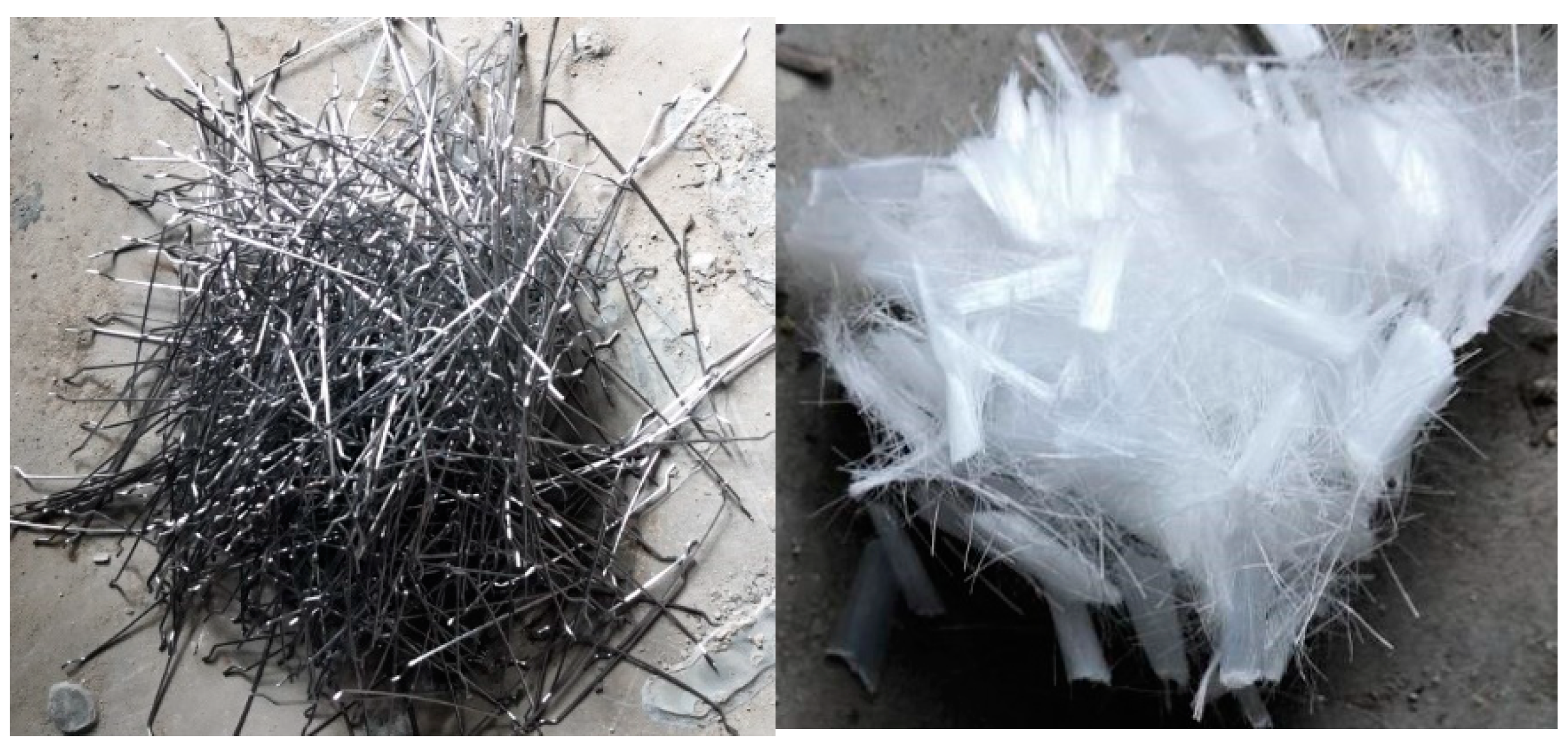

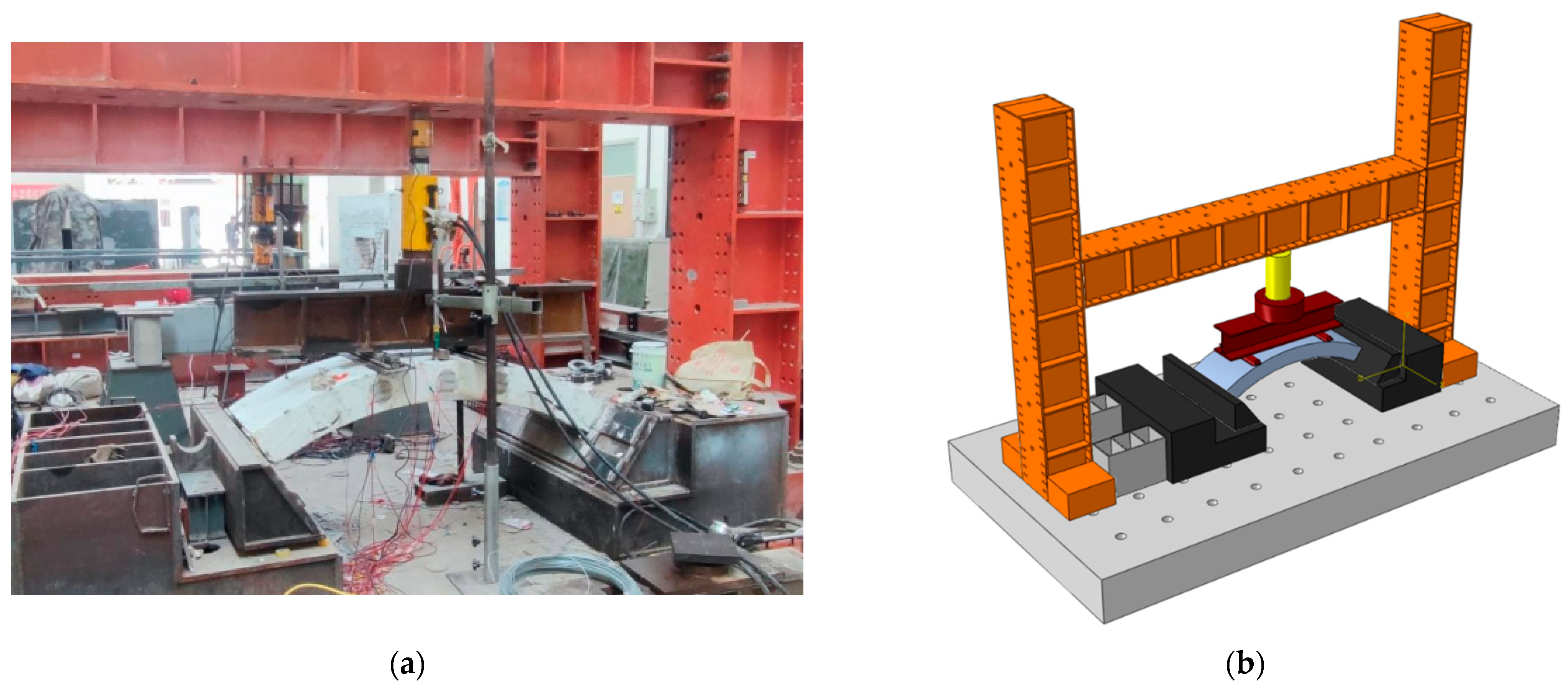
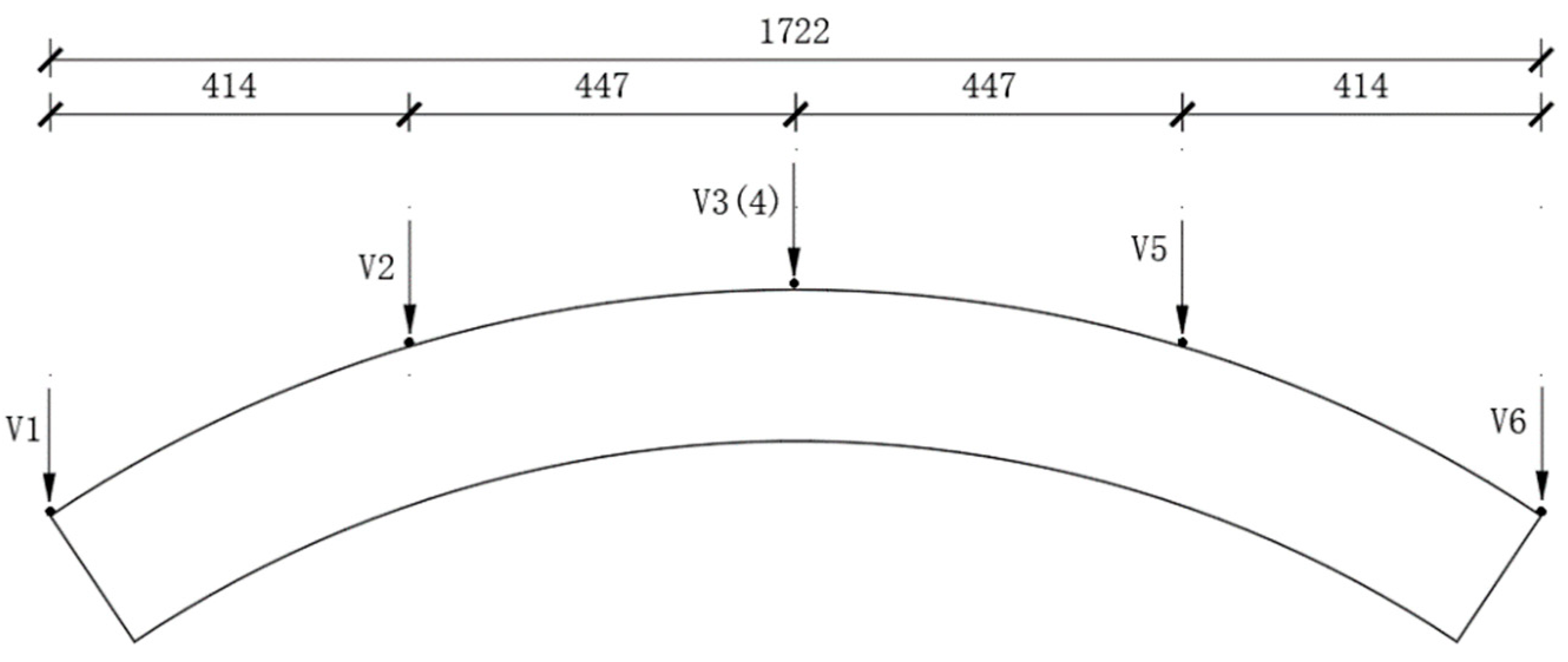
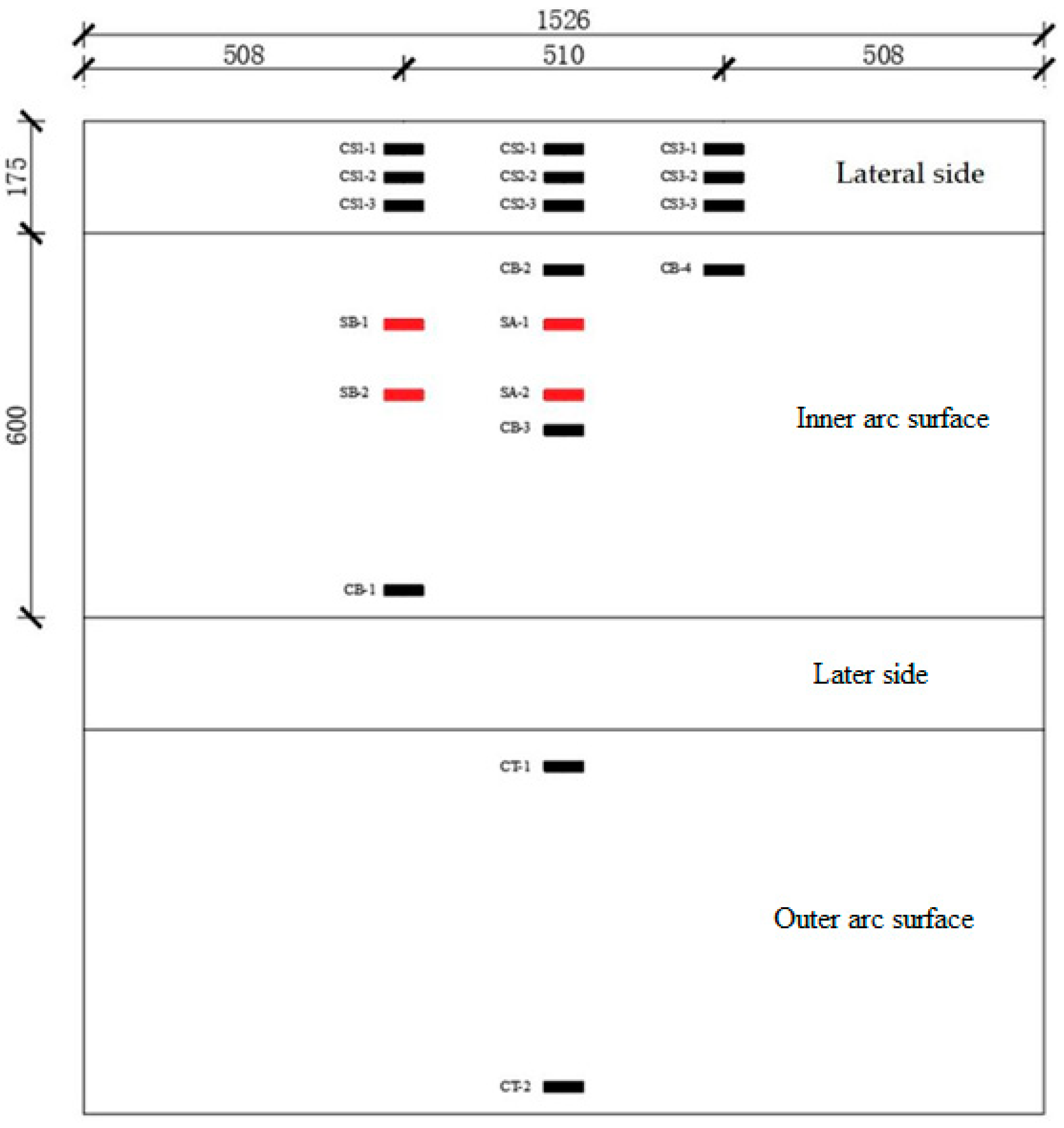
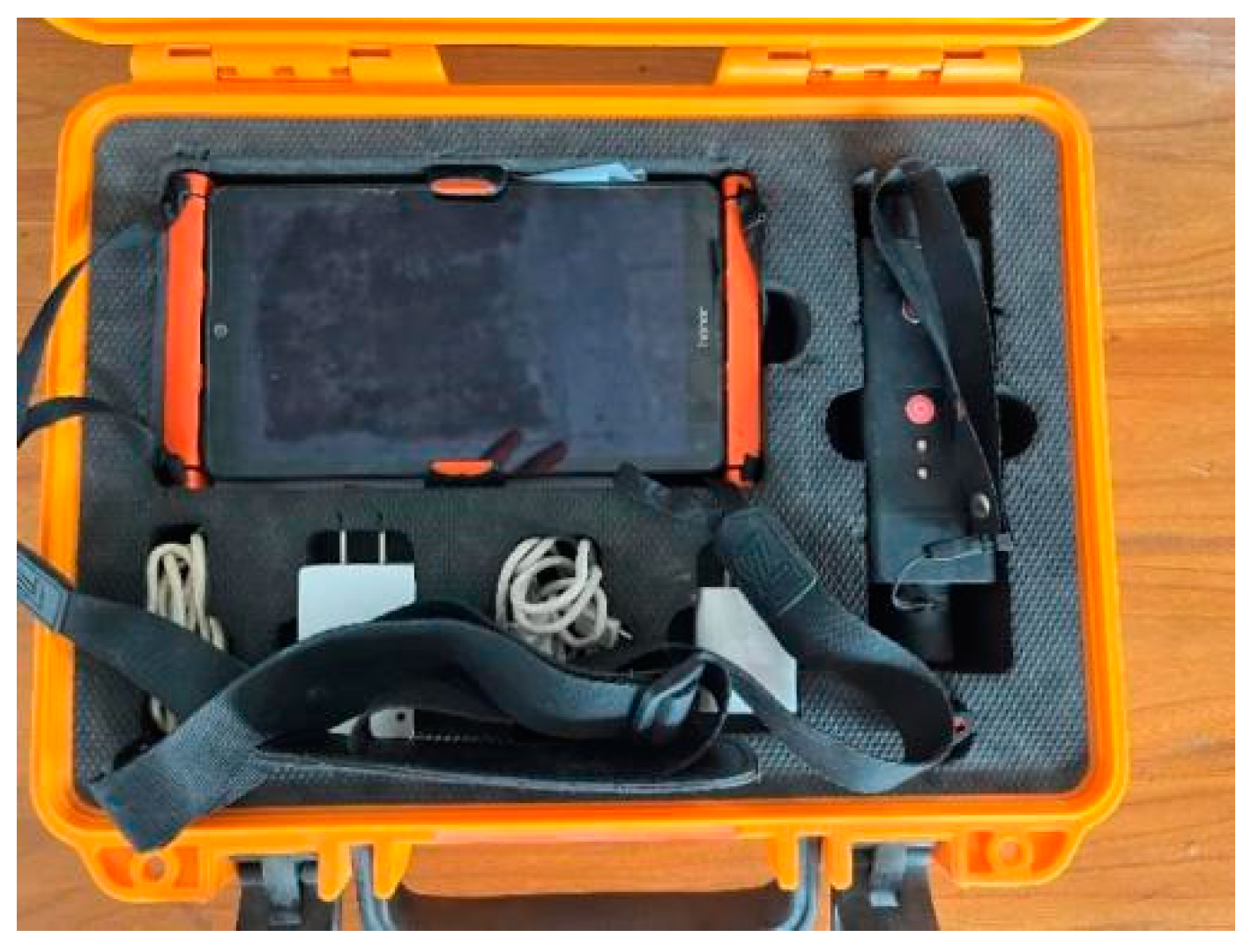


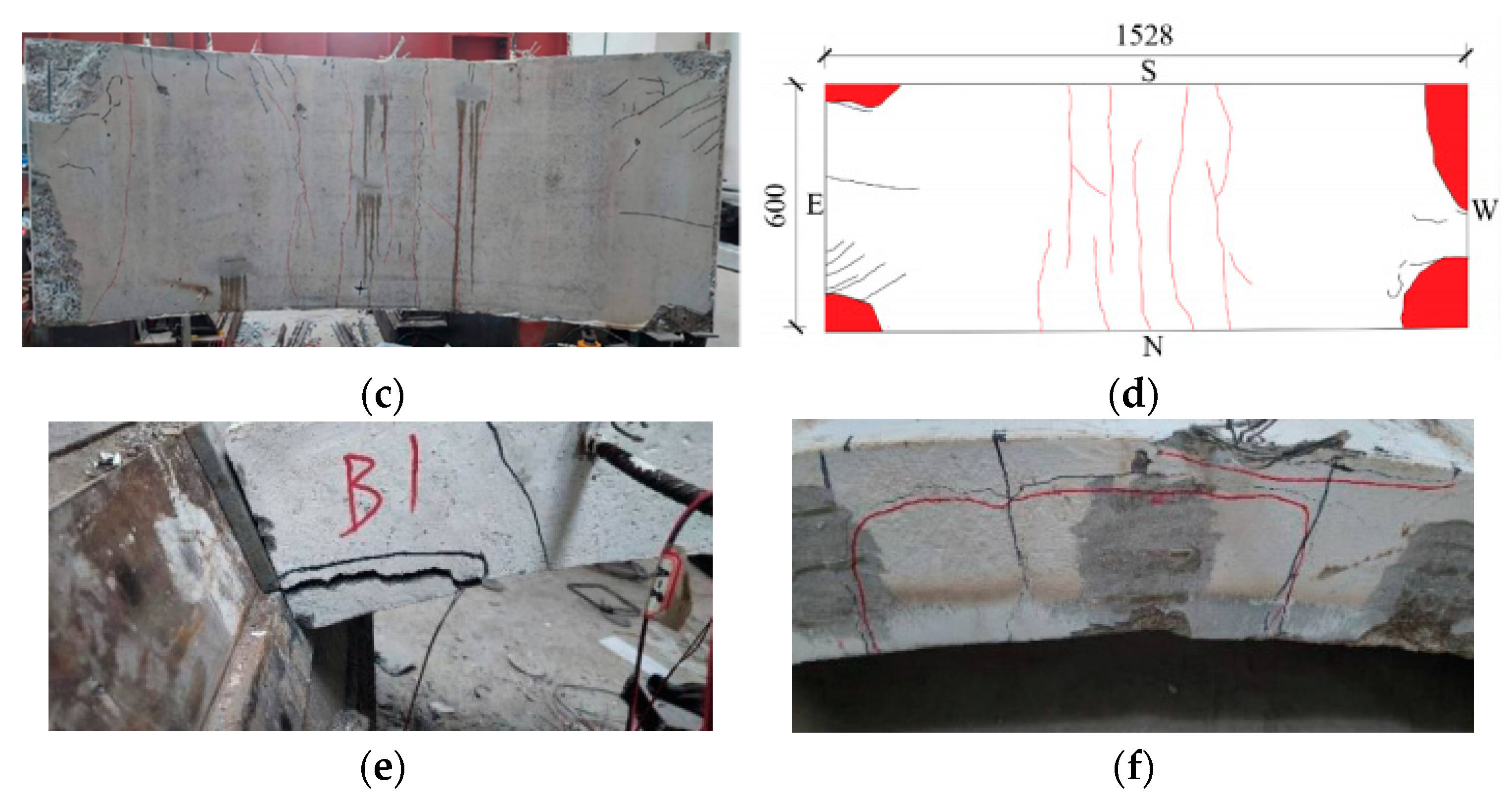
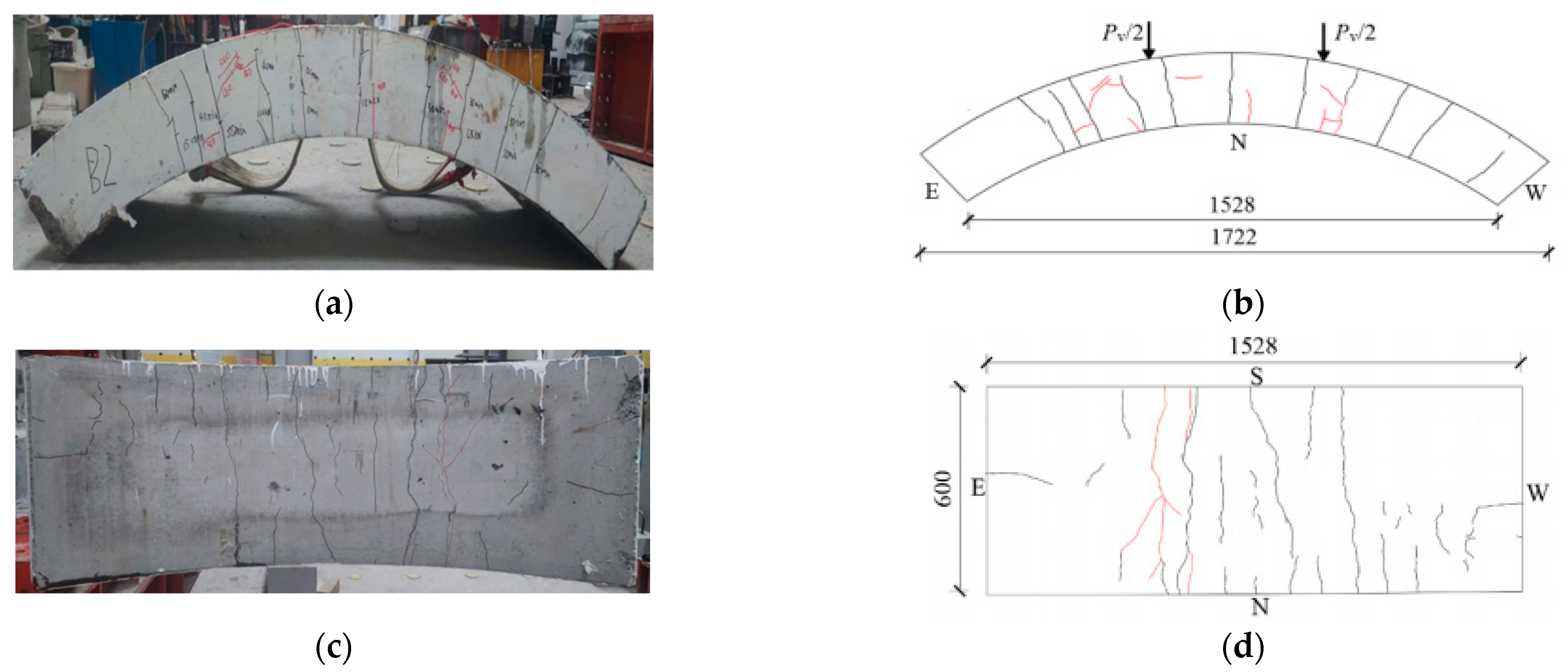
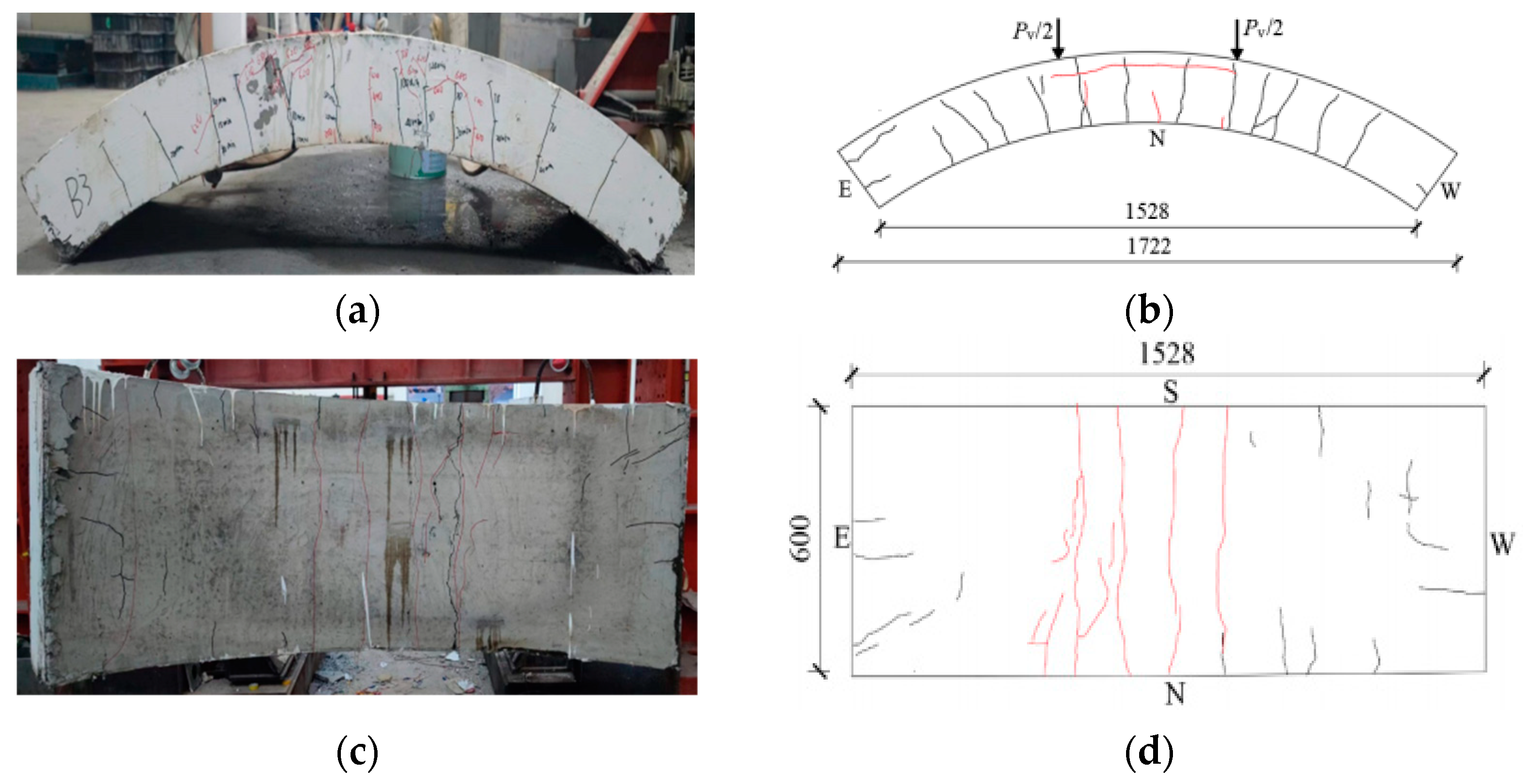
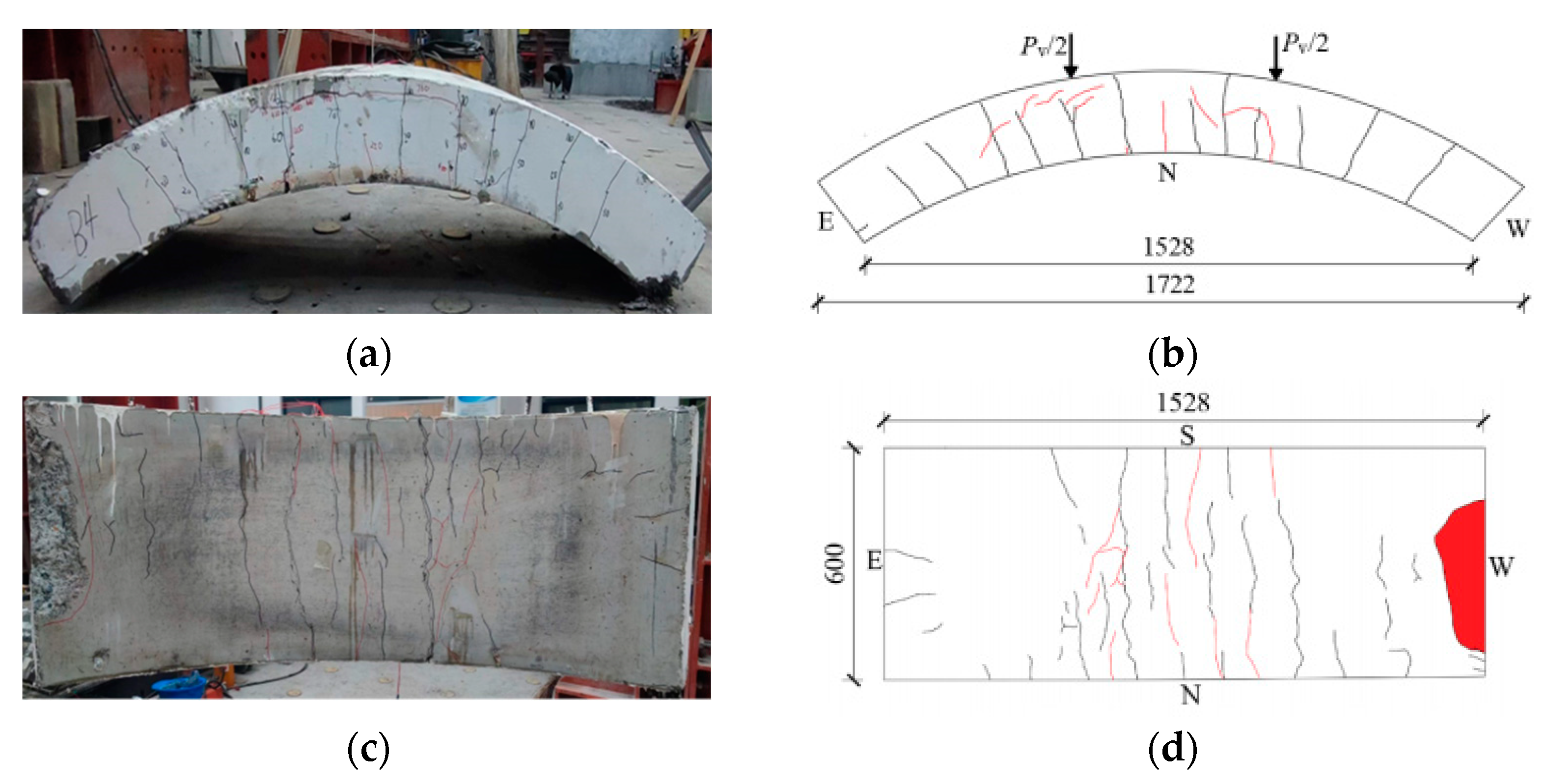
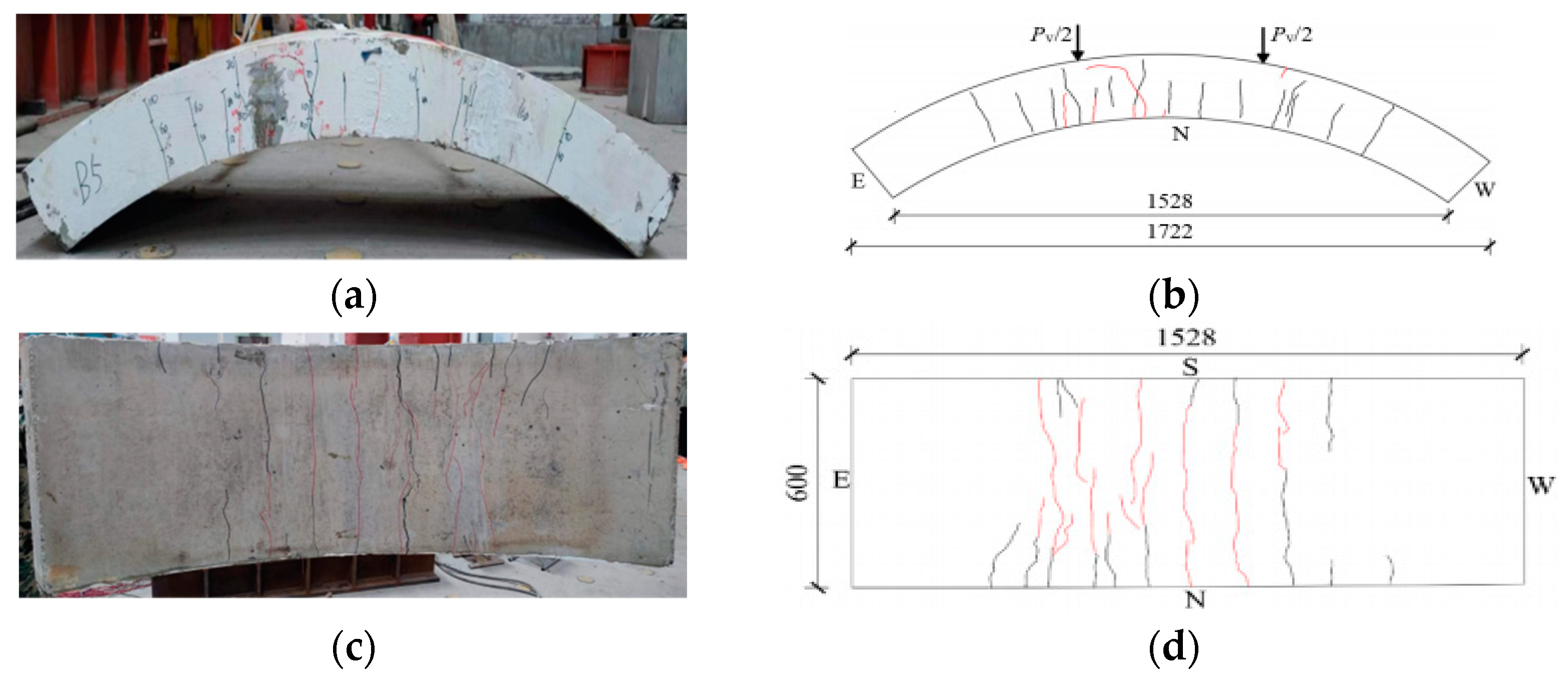

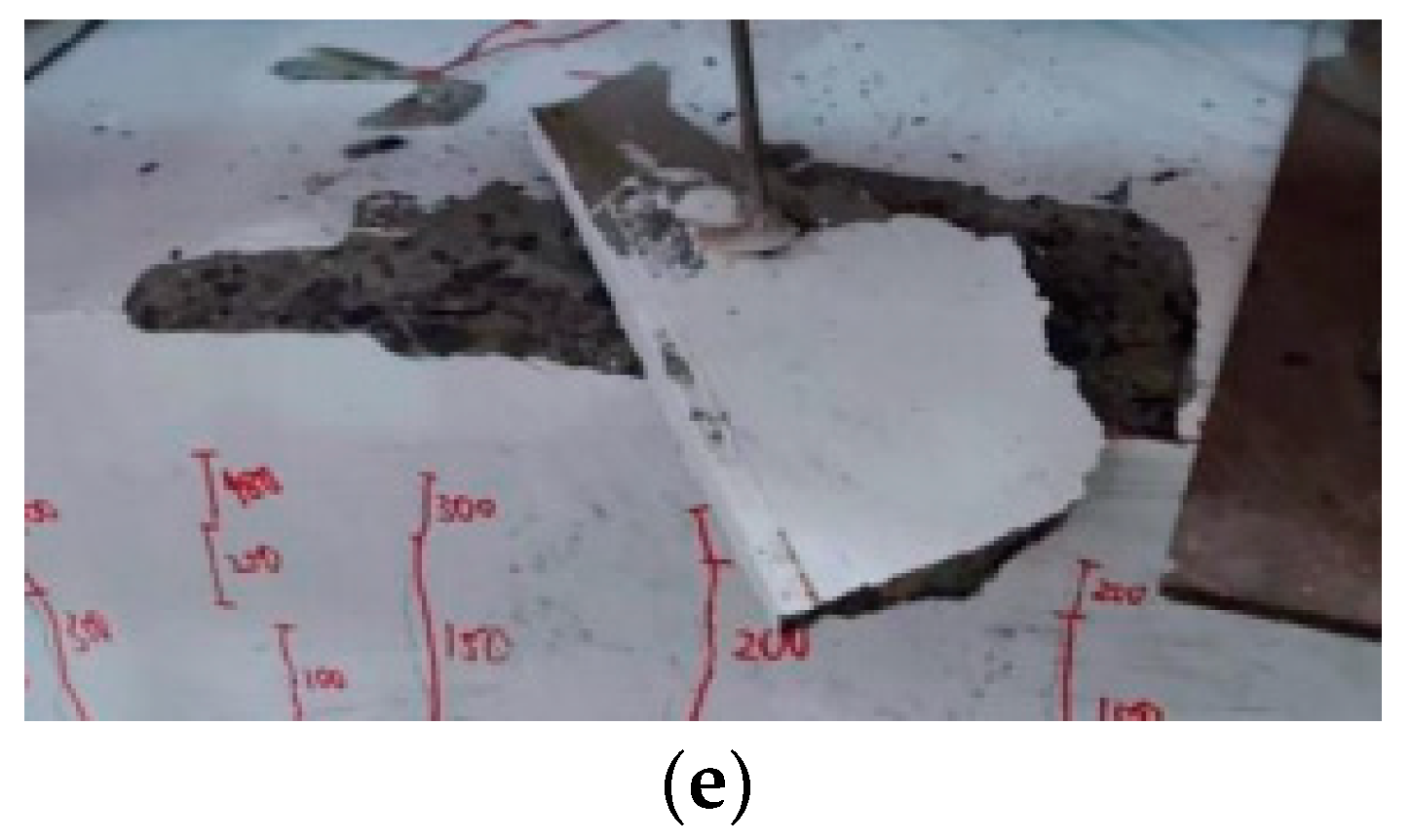

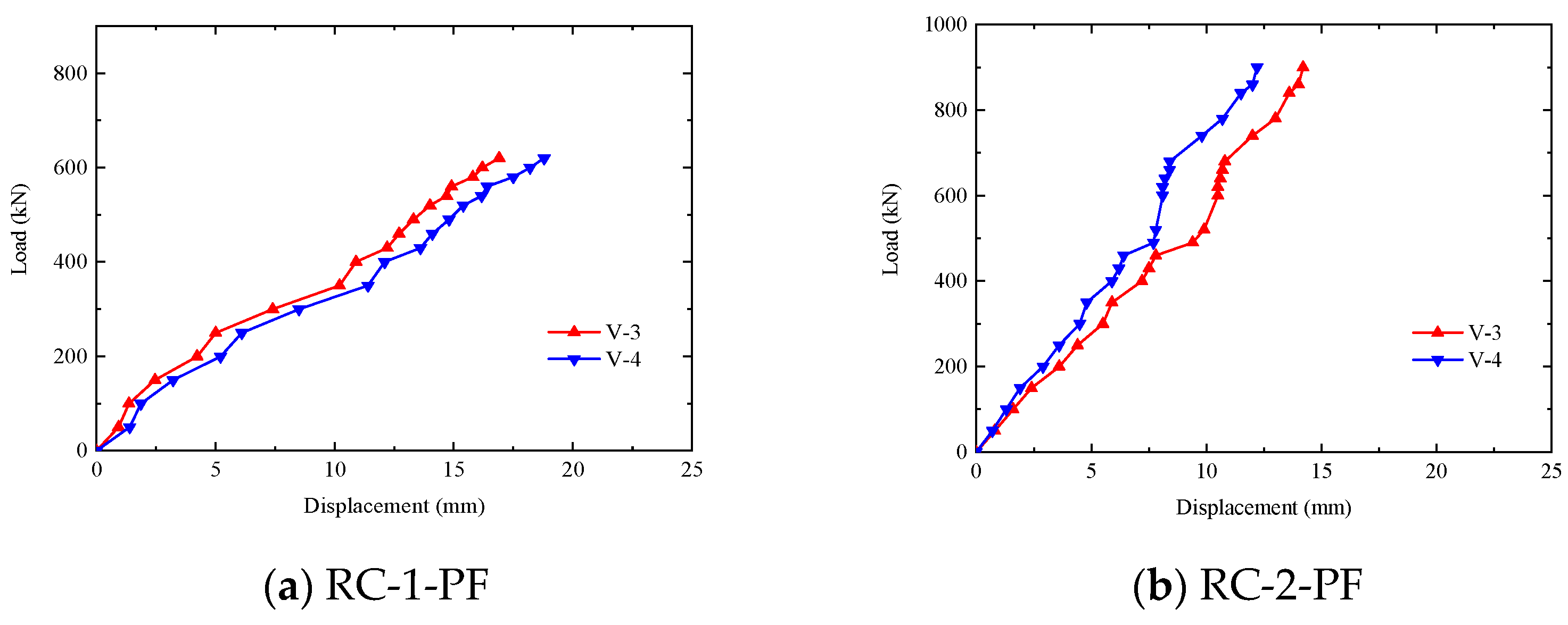
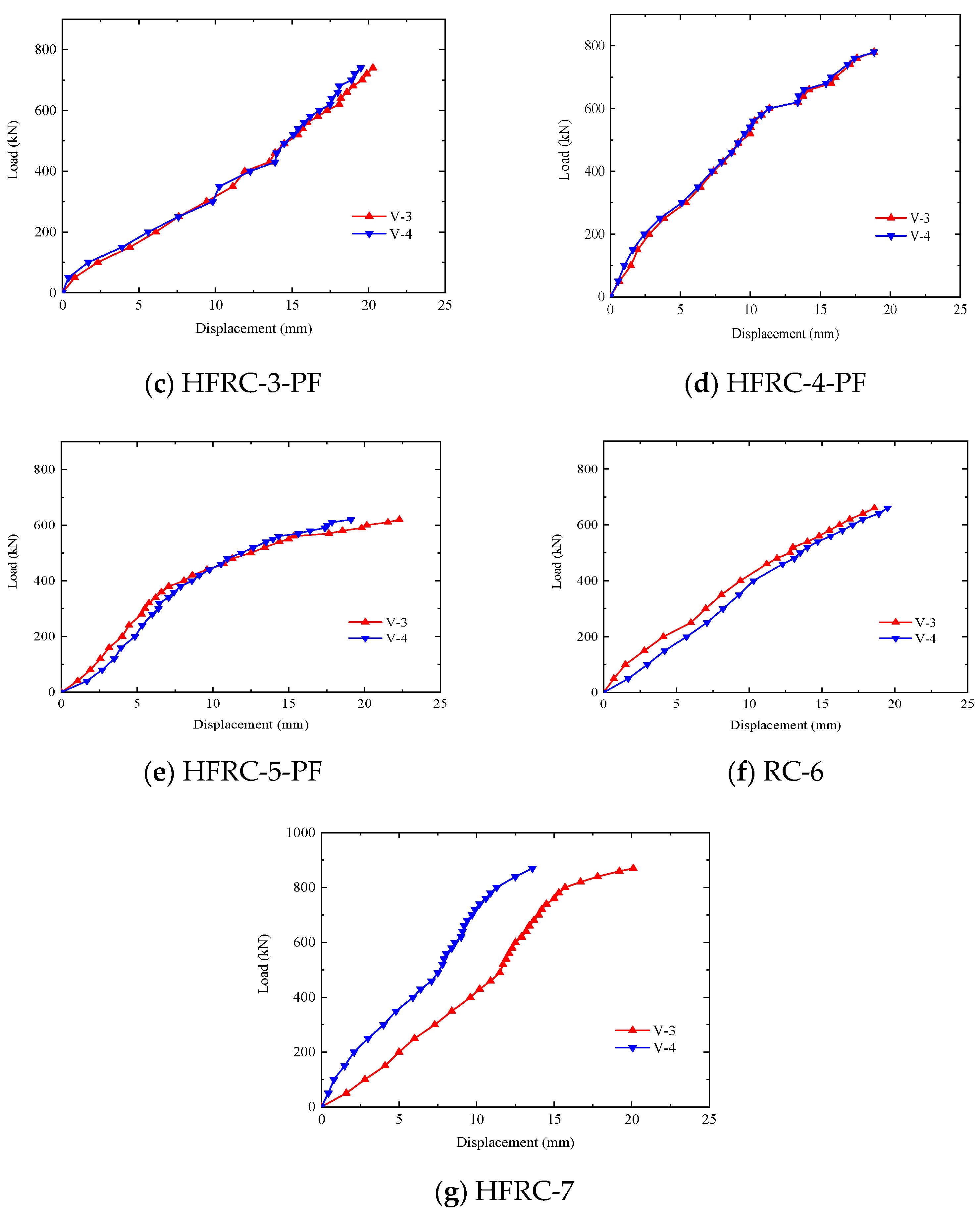
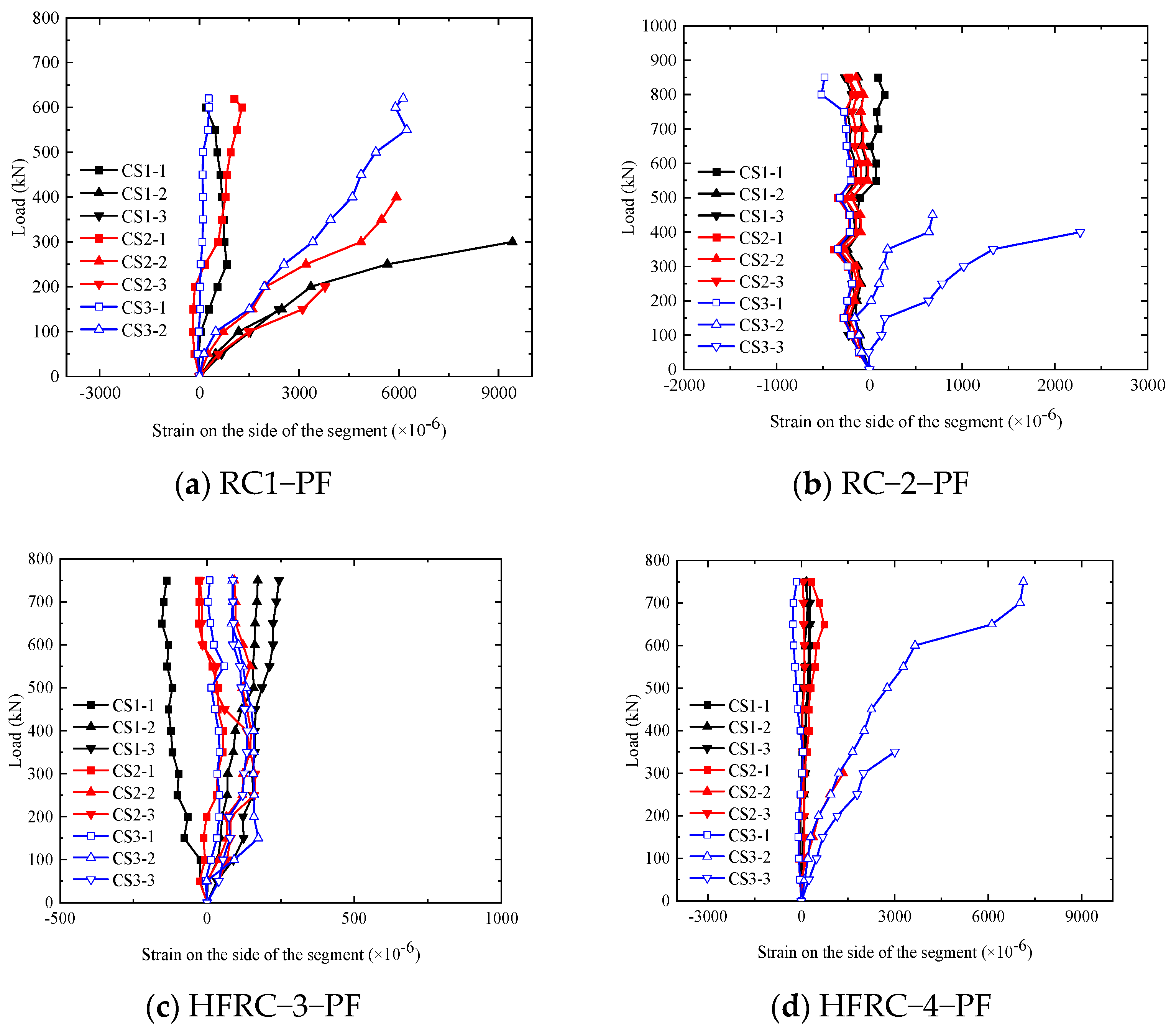
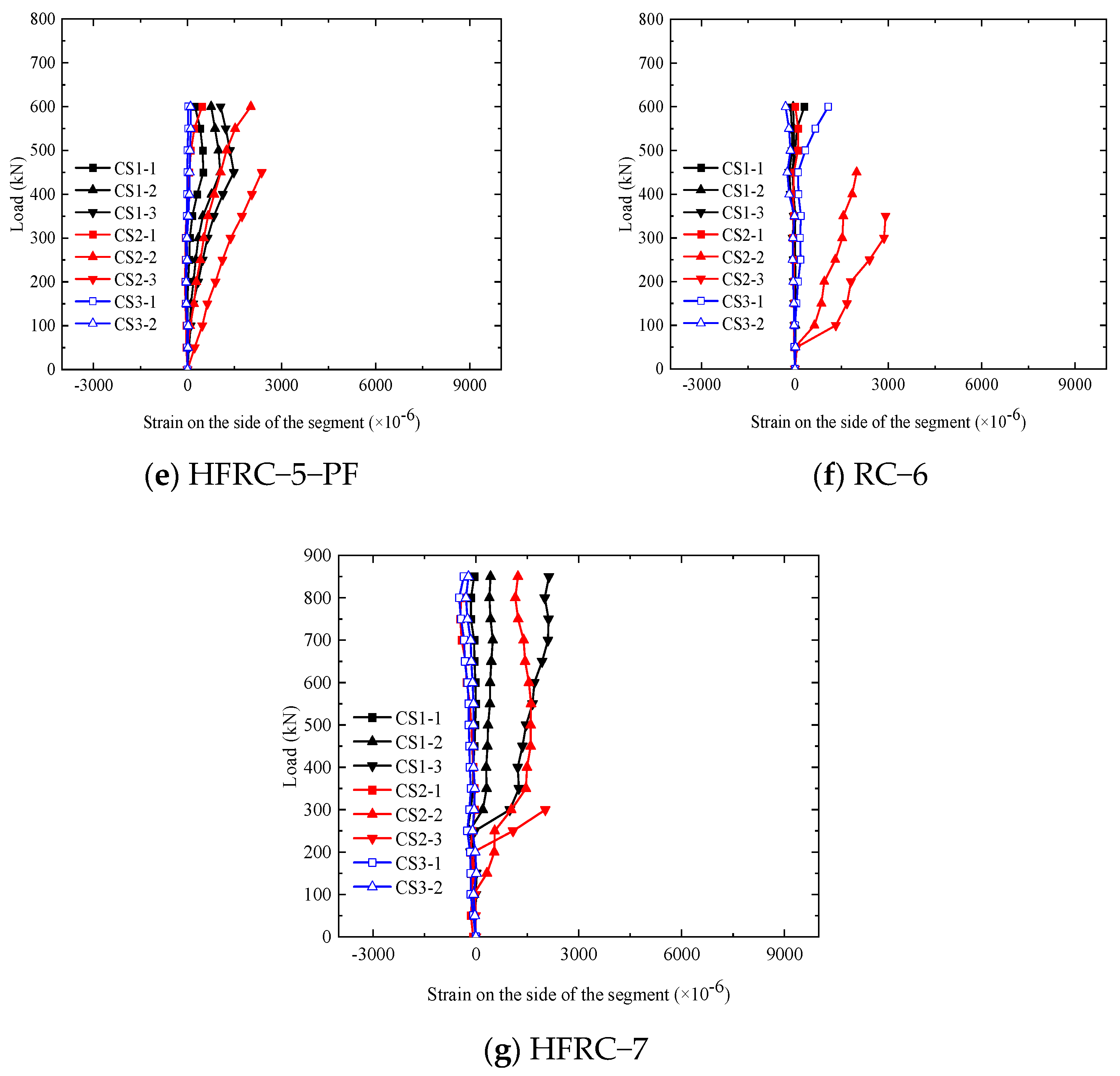
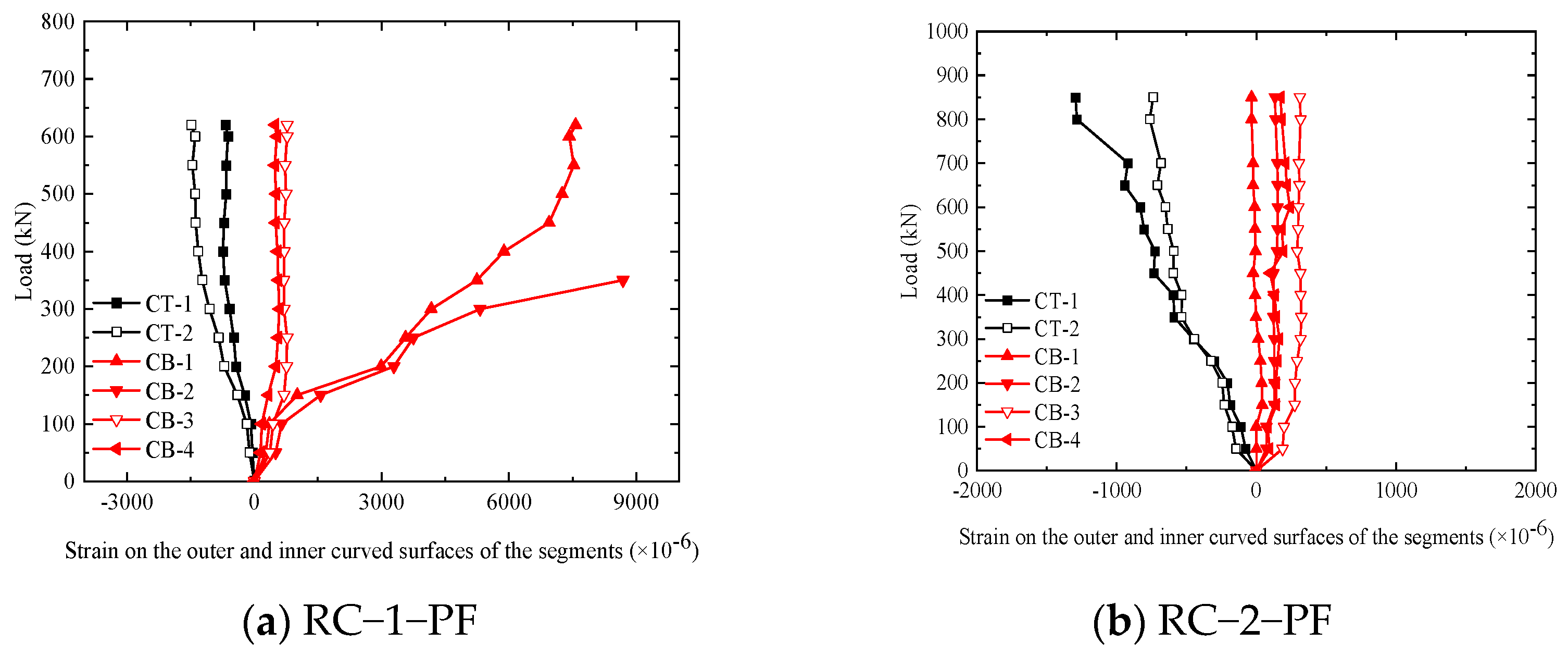
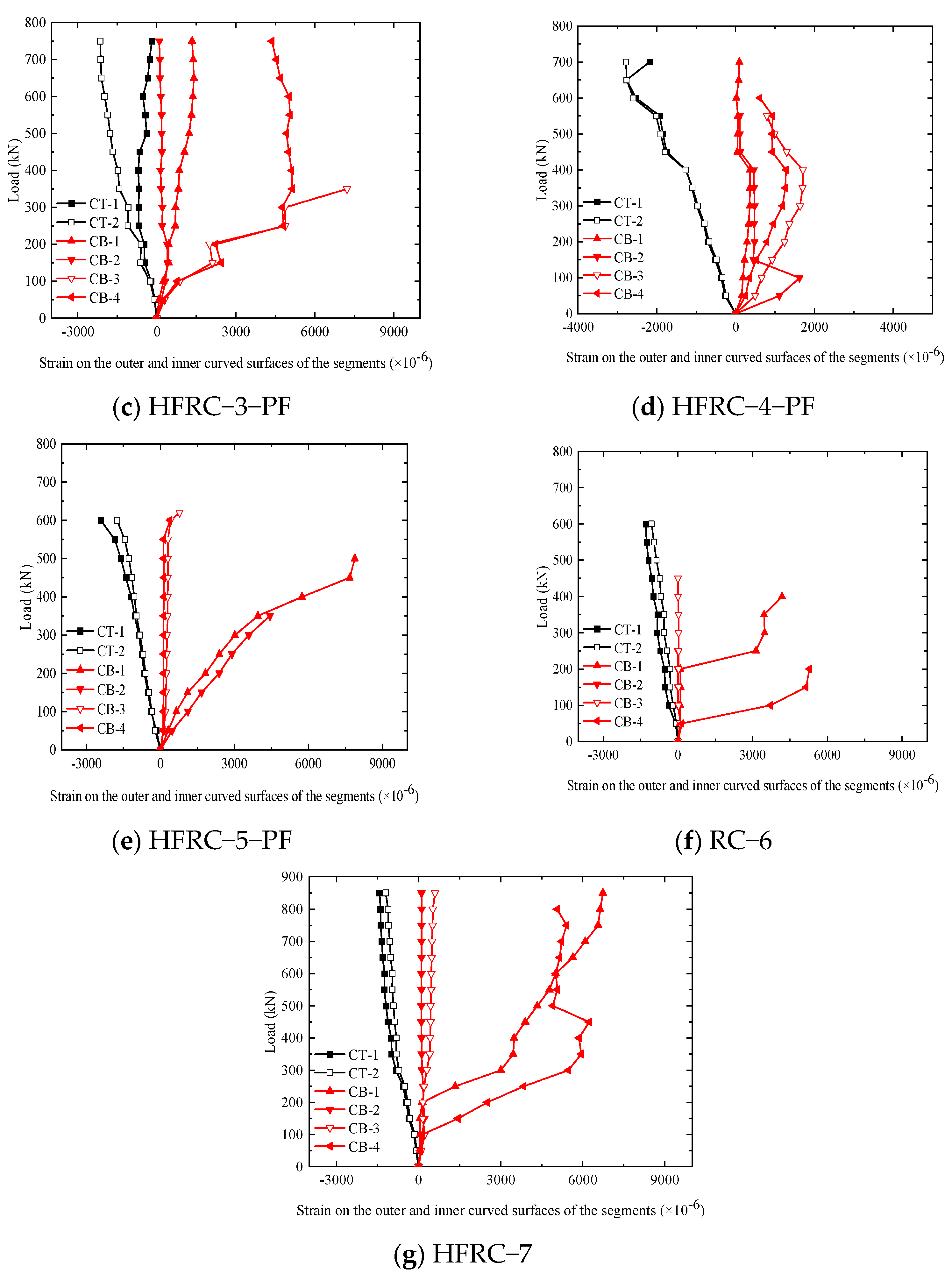
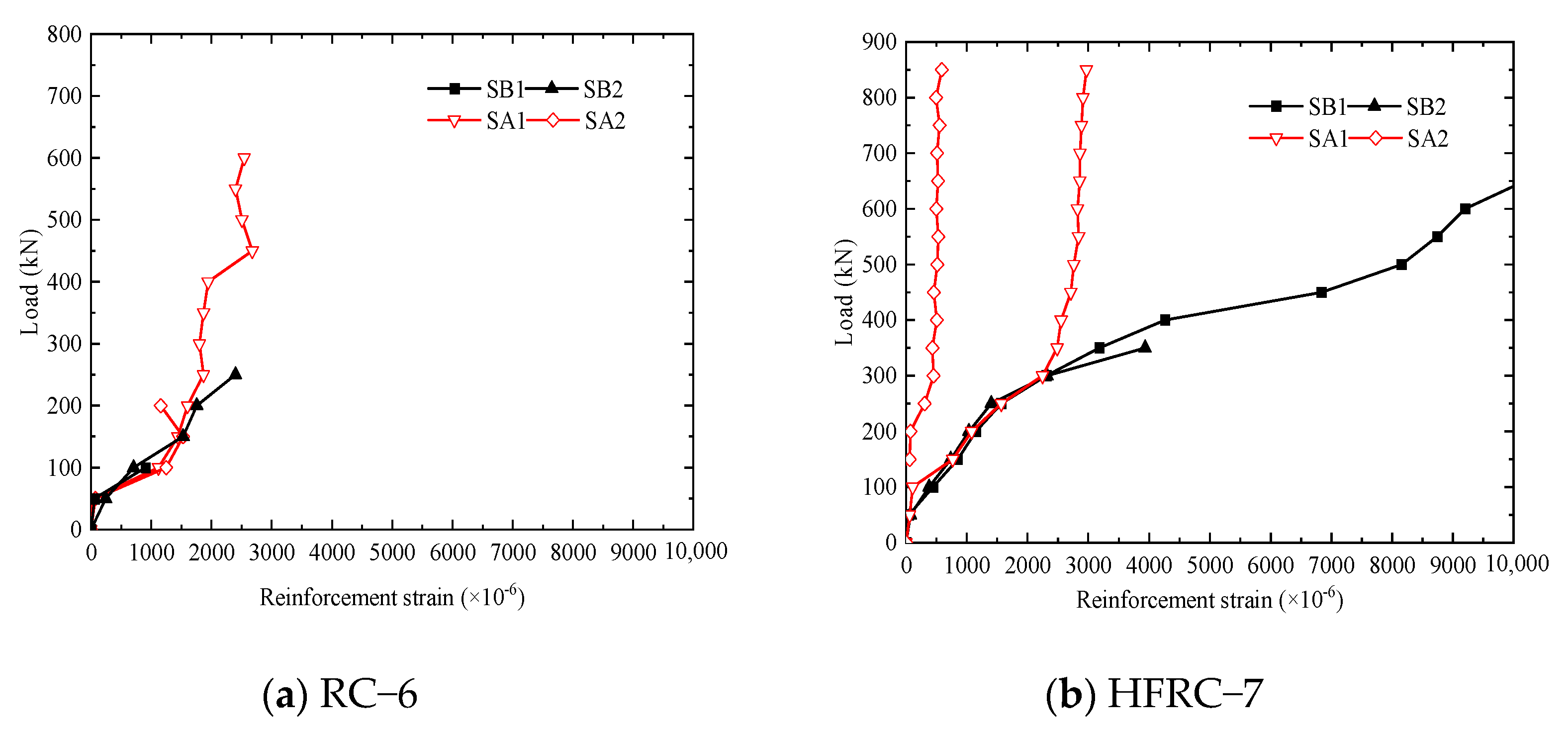
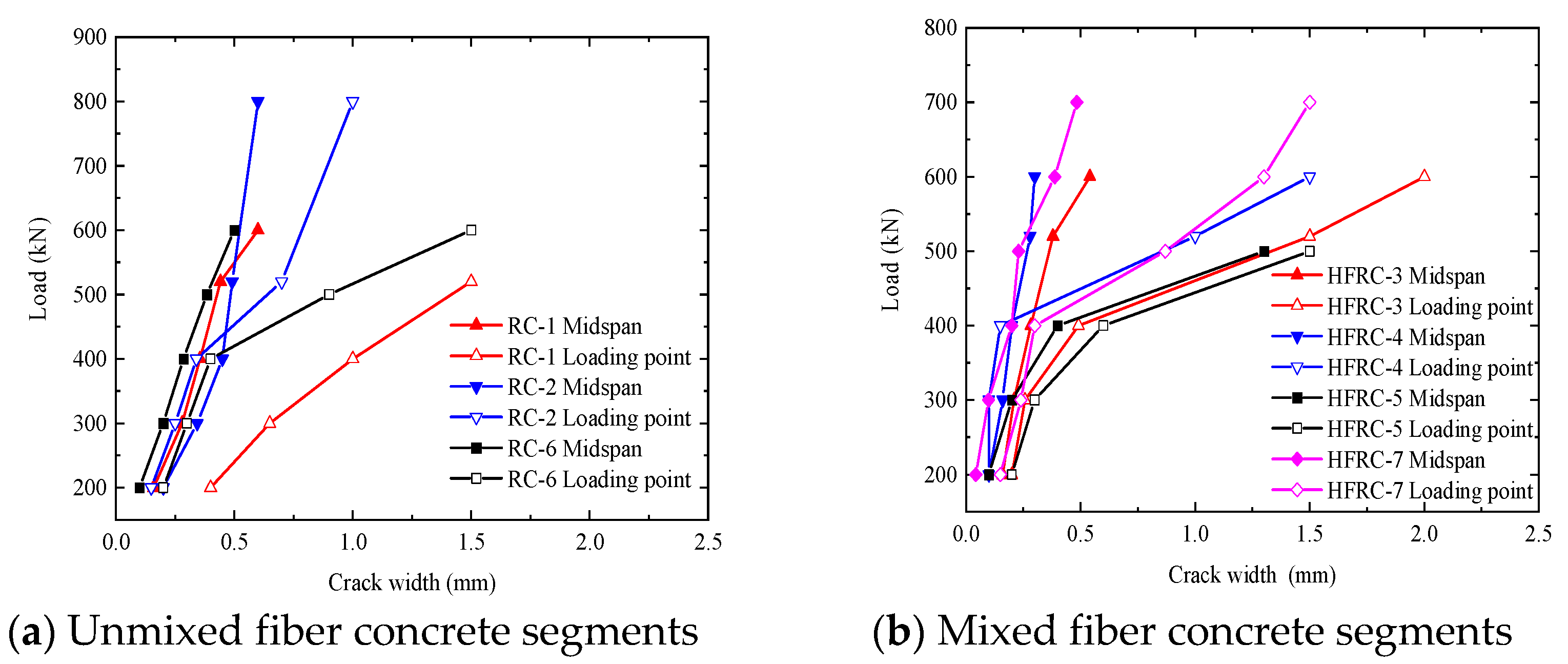
| Water | Cement | Sand | Stone | Powdered Coal Ash | Additives |
|---|---|---|---|---|---|
| 180 | 400 | 765 | 832 | 160 | 4.5 |
| Test Sample Number | Heating Time (min) | Load Size at High Temperature | Concrete (°C) | Steel Bar (°C) | Maximum Deformation at High Temperature (mm) | ||
|---|---|---|---|---|---|---|---|
| Bottom | Top | Lower Layer | Upper Layer | ||||
| RC-1-PF | 240 | PV = 60 kN | 471 | 113 | 405 | 127 | 2.47 |
| RC-2-PF | 180 | PV = 120 kN | 549 | 96 | 380 | 115 | 4.68 |
| HFRC-3-PF | 180 | PV = 60 kN | 533 | 94 | 368 | 115 | 2.68 |
| HFRC-4-PF | 180 | PV = 120 kN | 501 | 102 | 351 | 135 | 5.44 |
| HFRC-5-PF | 150 | PV = 180 kN | 460 | 101 | 397 | 117 | 5.60 |
| RC-6 | room temperature | ||||||
| HFRC-7 | room temperature | ||||||
| Average value | 503 | 101 | 380 | 122 | |||
| Test Segment Number | Number of Cracks | Average Crack Width (mm) |
|---|---|---|
| RC-1-PF | 3 | 1.05 |
| RC-2-PF | 5 | 0.80 |
| HFRC-3-PF | 4 | 1.30 |
| HFRC-4-PF | 5 | 0.90 |
| HFRC-5-PF | 4 | 1.40 |
| RC-6 | 8 | 1.00 |
| HFRC-7 | 7 | 1.00 |
| Average value | 5 | 1.06 |
| Test Sample Number | Ultimate Load/kN | Ultimate Deflection/mm | Failure Characteristic |
|---|---|---|---|
| RC-1-PF | 620 | 16.9 | Concrete crushing |
| RC-2-PF | — | — | — |
| HFRC-3-PF | 740 | 20.3 | Concrete crushing |
| HFRC-4-PF | 780 | 18.84 | Concrete crushing |
| HFRC-5-PF | 680 | 22.29 | Concrete crushing |
| RC-6 | 680 | 19.5 | Concrete crushing |
| HFRC-7 | 880 | 20.1 | Concrete crushing |
Disclaimer/Publisher’s Note: The statements, opinions and data contained in all publications are solely those of the individual author(s) and contributor(s) and not of MDPI and/or the editor(s). MDPI and/or the editor(s) disclaim responsibility for any injury to people or property resulting from any ideas, methods, instructions or products referred to in the content. |
© 2024 by the authors. Licensee MDPI, Basel, Switzerland. This article is an open access article distributed under the terms and conditions of the Creative Commons Attribution (CC BY) license (https://creativecommons.org/licenses/by/4.0/).
Share and Cite
Zong, G.; Wang, Y.; Wang, Y.; Ren, Z. Test Research on Residual Mechanical Properties of Fiber-Reinforced Concrete Segments after High Temperature. Materials 2024, 17, 1418. https://doi.org/10.3390/ma17061418
Zong G, Wang Y, Wang Y, Ren Z. Test Research on Residual Mechanical Properties of Fiber-Reinforced Concrete Segments after High Temperature. Materials. 2024; 17(6):1418. https://doi.org/10.3390/ma17061418
Chicago/Turabian StyleZong, Gang, Yao Wang, Yong Wang, and Zhaoqing Ren. 2024. "Test Research on Residual Mechanical Properties of Fiber-Reinforced Concrete Segments after High Temperature" Materials 17, no. 6: 1418. https://doi.org/10.3390/ma17061418






